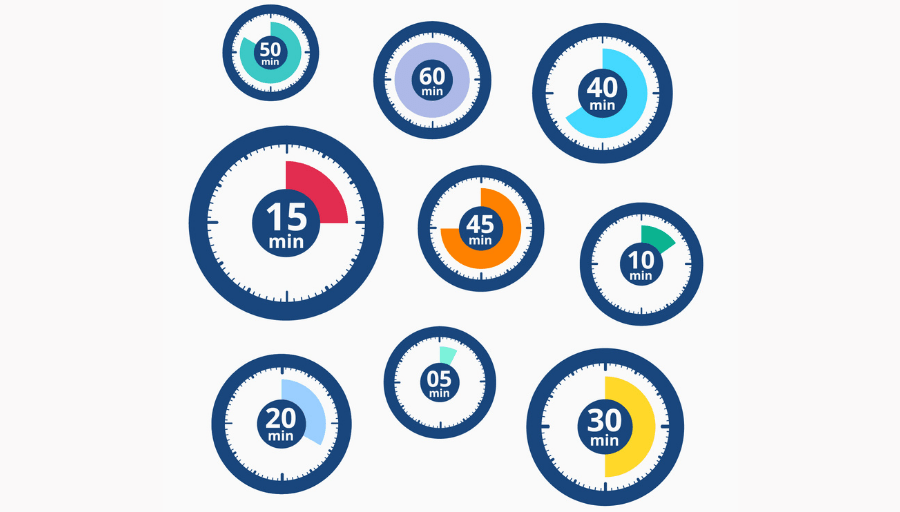We’ve all heard the advice to write daily, to allow time for deep work and uninterrupted focus. But for many writers, that’s just not possible. Find out about time confetti and how to write spontaneously when scheduled sessions just aren’t possible.
No time to write
“I mean, none of us anymore have long leisurely uninterrupted days to write,” said Cynthia Selfe*. A distinguished humanities professor-emeritus at the Ohio State University, Selfe is a prolific writer, with five books, 10 edited collections and nearing a hundred papers to her name. Yet she has no time to write.
Her solution is to fit writing around her other tasks, what she calls “small little moments of the day.” These can be ten minutes, five minutes, or even just two minutes. She finds the time in between a student conference and a committee meeting, in between a class that she teaches and her yoga exercise. She likes to write when she’s doing other things, like watching TV and during faculty meetings when she tackles essential writing admin, such as indexing, or mindless tasks that are small enough to pay attention to at the same time.
Selfe said: “There’s all these demands in our day, so if I can’t use these small times or interstices of my day, then projects don’t get done.”
>> Read more: Prioritize your writing – make writing matter and make it happen
What is time confetti?
It’s surprising how the small intervening spaces add up. Author Brigid Schulte, a working mother of two children, felt she had no time; what time was available was fragmented and interrupted by child care and housework. Yet when she took part in a time use study, the researchers discovered she had 27 hours available each week.
Schulte coined the phrase ‘time confetti’ which are the: “bits and scraps of garbagey time. Five minutes here. Ten minutes there. Listening to the radio, exhausted, trying to get out of bed. Getting some exercise. Waiting by the side of the road for a tow truck.”
This isn’t productive time, those golden hours when energy is high, attention is great and you’re about to lose yourself in a state of flow. It’s confetti, scraps of time. But if that’s all you’ve got – use it, says Ashley Whillan, a negotiation specialist who studies how people navigate trade-offs between time and money and the author of Time Smart: How to Reclaim Your Time & Live a Happier Life.
With four out of five adults feeling that they have too much to do and not enough time to do it, she found that time-poor people experience less joy each day, they laugh less, they are less healthy, less productive, and more likely to divorce. One of her solutions to escaping these time traps, is to make more of what time we have.
Spontaneous writing
That’s exactly what one group of writers we studied do. We found writers with schedules booked from dawn to dusk, or who have chaotic and unpredictable days, that they rely on unplanned, spur-of-the-moment writing.
Spontaneous writers grab any opportunity to write. They make the most of delayed trains, cancelled meetings and sleeping children to write. They are instinctive and can write anytime, anyplace, anywhere – whenever the opportunity arises. Like Selfe, our multi-tasking professor, they are not impulsive or inspiration-driven, but actually incredibly prepared. They have writing tasks to hand whenever the opportunity arises. They don’t get distracted and can find their focus fast.
>> Read more: Finding time to write: the spontaneous writer
This approach has been studied in academic writers. In How Writing Faculty Write Christine Tulley set out to create a Paris Review for scholarly writing. Her interview collection explores the writing habits and strategies of ‘rock stars’ like Selfe who work in the field of writing studies – people who write about writing, teach writing skills and research writing behaviours. If you want to find out how writers write, then this group contains the experts to ask!
Tulley found patterns emerge from the interviews, namely, that the writing strategies these scholars developed over time were from necessity rather than choice. One specific technique has evolved over time – one that can be used by any kind of time-starved writer – and that’s to write in very small pockets of time. She explains:
“Many writers use a system they describe as ‘toggling’ where they use tiny amounts of time during the day to get some writing done. If they see they have just five or ten minutes before a phone call or have to attend a meeting, they immediately switch over to their writing. Instead of filling the time by checking email or doing an admin task, these writers prioritise their writing – over everything else. Having regular contact with their project over the day means they don’t lose momentum with it.”
>> Read more: How writing scholars write: productivity tips from the best of the best
The upsides of small writing moments
Tulley admits that whilst it’s unlikely that any deep work occurs, she observed that writers are able to do something that moves their project on – like checking through a paragraph or making a tweak here and there.
In fact, having small pockets of time can be more helpful than having longer scheduled writing time. She says: “One writer told me it works for them because the pockets of time are so small. Because it’s just 10 minutes, nobody is trying to steal it from you. Once you get to the point where you have 30 minutes free, someone will want to take it.”
The reality for the writing scholars that Tulley interviewed is that they might have an hour a day but it is scattered into ten- and fifteen-minute intervals, that calls for ‘toggling’ between projects.
While also being a helpful way to make the most of time confetti, other benefits include enabling the writer to restart quickly as they are in repeated contact with their work, which has led to a quick focus approach to writing.
>> Read more: How to make time to write – 4 approaches to finding time in busy schedules
The downsides of time confetti
This finding goes against much of the research on how to be productive. Most writing guides advocate for daily writing sessions, of an hour or two in order to be productive. However, as we say at Prolifiko, productivity is personal and while it’s helpful to find out what works best, we all need to write within the realities of own lives.
Of course, there are downsides. Spontaneous writing is driven by need – not one designed for deep focus or flow. That means writers rarely have the space to step back and consider the bigger picture; what and why they are writing.
Many struggle with organization, planning and editing where a more strategic overview is required.
And if working on a large project like a novel or thesis, it will take significant persistence, and a lot of small snatches of time, to finish.
How to make the most of your time confetti
- Be prepared to write. Have the right tools to hand and know what you are writing next so you can hit the ground running.
- Don’t procrastinate! When an opportunities arises grab it – if you’re stuck, try freewriting.
- Use down time between your writing sessions to research, gather ideas and make plans – there might not be time for writing, but you can keep your project in mind and make progress with related activities.
- Notice when you do find time. After a while you might spot patterns in the opportunities available, and be able to turn them into a habit.
Finally, heat up a quiche. One writer told us. “I despaired of having any time to write,” she said. “Then I put a quiche in the oven and started writing. I managed to find 45 minutes that I did not know I had. I would never have thought that I could produce five pages while waiting for a quiche to heat up and cool down again.” She realised that breaks for cooking and eating were perfect opportunities to write, and now makes the most of 10 minutes at lunchtime to move things forward.
*How Writing Faculty Write, by Christine Tulley, featuring an interview with Cynthia Selfe, pp 35-36. For details on how to order, a free download and bonus podcast check out The University Press of Colorado.
[et_bloom_inline optin_id=optin_7]




